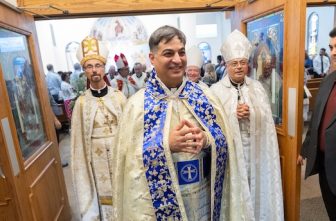The gospels for the Solemnity of the Most Holy Body and Blood of Christ, Corpus Christi, Year A, and for the Eighteenth Sunday of Ordinary Time, Year A, is taken from the Gospel of Matthew. It is his account of the multiplication of the loaves and fishes and the feeding of the five thousand (Mt 14:13-21).
This event was so remarkable and noteworthy that all four evangelists chose to include it in their narratives. While the overall stories have strong similarities, there are a few differences, particularly the number, gender, and age of those who were fed. Mark, Luke, and John all say that five thousand men were fed (Mk 6:44; Lk 9:14; Jn 6:10). Matthew is the sole evangelist to add a curious parenthetical detail, “not counting women and children” (Mt 14:21), a comment he repeats in the feeding of the four thousand (Mt 15:38).
So women and children don’t count! Outrageous! Many find this comment to be troubling and offensive. It sounds sexist toward women, demeaning toward children, and frankly, not very loving or Christ-like. What could Matthew possibly mean? Is this comment as bad as it sounds?
Ancient society was thoroughly patriarchal. Society was tiered, and men were on the top rung of the social ladder, women on the second, children on the third, and slaves on the fourth. Most of the writings of that time had a strong male bias. Cynics have quipped, “Ancient literature was written by men, about men, and for men.”
Matthew slyly included women and children, not to denigrate them, but to acknowledge that they were present. His observation challenged ancient patriarchy. While men regularly viewed themselves as superior to others and overlooked or excluded women and children, Jesus welcomed, counted, and included them. Whether at the feeding miracle, in the Body of Christ, or at the eternal banquet, men, women, and children are all equally welcome.
Furthermore, Matthew used this detail to magnify the spectacular nature of the feeding miracle. If five thousand men were present, then, most likely, five thousand women were also present. And if every couple had two children, then there were ten thousand boys and girls in the crowd, which means that the total size of the multitude that was feed was not five thousand, but twenty thousand, which makes Matthew’s version of the multiplication far more miraculous than the other three gospels. And if Jesus could take five loaves and two fishes to feed twenty thousand, then Jesus is great indeed, the Lord, the Messiah, the Son of the living God.





